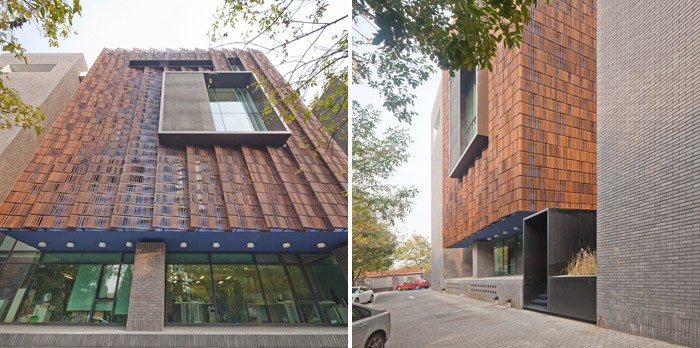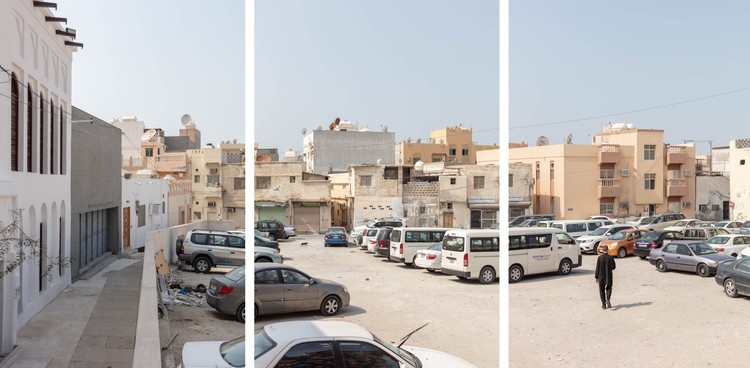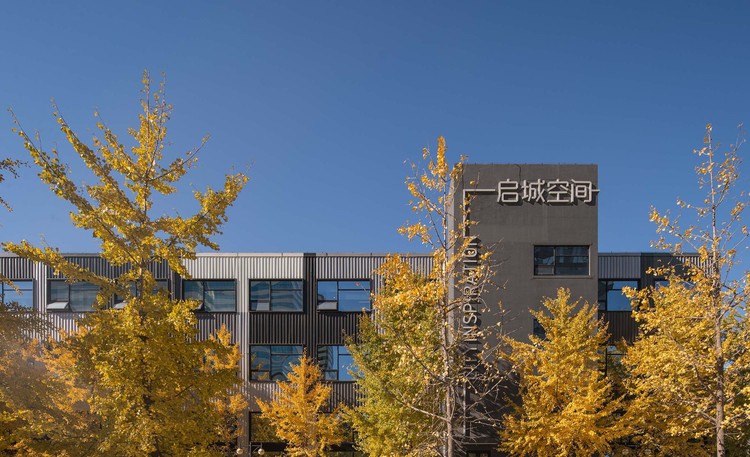ISOROPIA Center for Information Technology and Architecture
2018-10-13 02:00
架构师提供的文本描述。等角平衡(希腊意为平衡、平衡和稳定)是一种张力和压缩的精细调节平衡。在这里,定制的不同材料性质的针织纺织品嵌入活性弯曲玻璃纤维棒,并在一起找到它们的平衡和形式。等观研究如何让计算设计让我们重新思考材料在建筑中的使用。在这里,我们发现,这一职业来自于一种传统,即添加材料来形成建筑元素和建筑,这种做法是非常浪费的。目前的技术和材料不仅将耗尽我们星球的资源,而且也无法满足不断增长的全球人口的住房需求。我们需要的是更智能的材料、工艺和建筑技术。同质城提倡一种更轻巧的建筑,在这种建筑中,材料行为-材料的弯曲和拉伸-被积极地用来建造更聪明的建筑。
Text description provided by the architects. Isoropia (greek meaning balance, equilibrium and stability) is a finely tuned balance of tension and compression. Here, bespoke knitted textiles with varying material properties embed active bent fiberglass rods and together they find their equilibrium and form. Isoropia investigates how computational design allows us to rethink material use in architecture. Here the profession comes from a tradition of adding materials to form building elements and buildings, we find, that this practice is highly wasteful. Current techniques and material will not only deplete the resources of our planet, but are as well not able to satisfy the need for housing of the globes growing population. What is needed - are smarter materials, processes and technologies for building. Isoropia advocates a lighter architecture in which material behaviors - the bending, and stretching of materials - are actively employed to build smarter with less.
Text description provided by the architects. Isoropia (greek meaning balance, equilibrium and stability) is a finely tuned balance of tension and compression. Here, bespoke knitted textiles with varying material properties embed active bent fiberglass rods and together they find their equilibrium and form. Isoropia investigates how computational design allows us to rethink material use in architecture. Here the profession comes from a tradition of adding materials to form building elements and buildings, we find, that this practice is highly wasteful. Current techniques and material will not only deplete the resources of our planet, but are as well not able to satisfy the need for housing of the globes growing population. What is needed - are smarter materials, processes and technologies for building. Isoropia advocates a lighter architecture in which material behaviors - the bending, and stretching of materials - are actively employed to build smarter with less.
协同创新,设计过程的新工具-等价物-是协作创新的一个例子。它是学术界和实务界广泛的跨学科合作的产物。我们一起探索了将轻量级仿真集成到体系结构设计工具中的方法。传统的工具需要劳动密集的手工原型和精细的结构计算。正因为如此,设计后才会进行分析,增加了大多数建筑项目所需的成本和时间。然而,如果早期设计建模系统能够让人们理解材料的行为,那么就可以进行创新的结构和材料研究,从根本上挑战建筑的建造方式。这种草根创新是由社区主导和开源的,为想象建筑的物质实践创造了一个自由的空间。
Collaborative Innovation, new tools for Design Processes Isoropia is an example of collaborative innovation. It is the product of a broad interdisciplinary collaboration crossing academia and practice. Together we have explored methods for integrating lightweight simulation into architectural design tools. Traditional tools require labor intensive manual prototyping and elaborate structural calculation. Because of this, analysis happens after design and increases costs and time needed in most building projects. However, if early stage design modelling systems can allow an understanding of material behavior it can enable innovative structural and material investigations that radically challenge how architecture is built. This grassroots innovation is community led and open source, creating a free-space for imagining what the material practices of architecture can be.
Collaborative Innovation, new tools for Design Processes Isoropia is an example of collaborative innovation. It is the product of a broad interdisciplinary collaboration crossing academia and practice. Together we have explored methods for integrating lightweight simulation into architectural design tools. Traditional tools require labor intensive manual prototyping and elaborate structural calculation. Because of this, analysis happens after design and increases costs and time needed in most building projects. However, if early stage design modelling systems can allow an understanding of material behavior it can enable innovative structural and material investigations that radically challenge how architecture is built. This grassroots innovation is community led and open source, creating a free-space for imagining what the material practices of architecture can be.
多/性能的单材料等视研究如何设计与相互作用的行为。结构很少是单一材料或纯粹在拉伸或压缩。相反,它们是由多个材料组成的,每个材料都有各自的性能。在等远视中,弯曲活性玻璃纤维的拉伸力被针织纺织系统抵消。一个图案的定制设计允许通过最小化纺织品、加厚玻璃棒或拉紧纺织品凸起、结构的表达和形式的变化来控制膜性能。
Multi/performance with a monomaterial Isoropia examines how to design with interacting behaviors. Structures are rarely mono-material or purely in tension or compression. Instead, they are composed of multiple materials that each hold their own performance. In Isoropia the tensile forces of the bending active fiberglass are counterbalanced by the knitted textile system. Bespoke design of a pattern allows to steer membrane properties By minimizing the textile, thickening the fiber glass rod or tensioning the textile protrusions, the structure changes in expression and form.
Multi/performance with a monomaterial Isoropia examines how to design with interacting behaviors. Structures are rarely mono-material or purely in tension or compression. Instead, they are composed of multiple materials that each hold their own performance. In Isoropia the tensile forces of the bending active fiberglass are counterbalanced by the knitted textile system. Bespoke design of a pattern allows to steer membrane properties By minimizing the textile, thickening the fiber glass rod or tensioning the textile protrusions, the structure changes in expression and form.
针织纺织品的等高线是用针织物作为一种规模的纺织薄膜,这在以往的传统技术中是没有达到的。针织物比传统的叠层膜更柔软,更不均匀,可以在非常不同的尺度上使用。通过在计算设计环境和现代数字针织机之间建立我们自己的接口,我们能够控制缝纫水平的制作。纺织品是以定制贴片的形式生产的,其细节如通道、凸出和穿孔等直接从设计环境中控制。使用针织物使我们能够生产、塑造和整合材料本身内的所有建筑细节。有了这种新的技术,就不需要对制造出来的薄膜进行任何后处理-当它们从针织机出来时,它们就可以使用了。在建筑单元规模上建立零废物生产。由于多功能元件仅由一种材料制成,因此纤维可以很容易地在现有的回收过程中重复使用。
Knitted textiles Isoropia uses knit as a textile membrane on a scale, which was so far not achieved with this traditional technique ever before. Knit is softer and less homogenous than traditional laminated membranes and can be used at the very different scales. By building our own interfaces between the computational design environment and the contemporary digital knitting machines, we are able to control fabrication at stitch by stitch level. The textiles are produced as custom patches and detailing such as the channels, the protrusions and perforations are controlled directly from the design environment. Using the knit allows us to produce to shape and to integrate all construction details within the material itself. With this novel technique, there is no need for any post-processing of the fabricated membranes - they are ready for use, when coming out of the knitting machine. A zero waste production is established on building element scale. As the multifunctional elements are made from only one material, the fibers can be easily reused in existing recycling processes.
Knitted textiles Isoropia uses knit as a textile membrane on a scale, which was so far not achieved with this traditional technique ever before. Knit is softer and less homogenous than traditional laminated membranes and can be used at the very different scales. By building our own interfaces between the computational design environment and the contemporary digital knitting machines, we are able to control fabrication at stitch by stitch level. The textiles are produced as custom patches and detailing such as the channels, the protrusions and perforations are controlled directly from the design environment. Using the knit allows us to produce to shape and to integrate all construction details within the material itself. With this novel technique, there is no need for any post-processing of the fabricated membranes - they are ready for use, when coming out of the knitting machine. A zero waste production is established on building element scale. As the multifunctional elements are made from only one material, the fibers can be easily reused in existing recycling processes.
新的创新材料等级化发展自己的材料系统,以指导材料行为和详细的建筑规模。这种独特的能力是首次在建筑规模上使用Dyneema纤维获得的。Dyneema纤维是世界上最强的纤维,用于海洋工业中的重物起重或个人防护装置。它比钢丝强15倍,轻8倍,不吸收水或其他液体,抗紫外线稳定。在等远视中,纤维的非弹性特性为创造一种材料提供了必要的基线强度,它可以适应和转化,创造一种诱人的空间体验。
New innovative material Isoropia develops its own material system, in order to steer material behaviour and detailing on building scale. This unique ability is granted through the first time ever use of Dyneema fibres in building scale. Dyneema is the strongest fiber in the world and used in maritime industry for heavy weight lifting or in personal protection gear. It is 15 times stronger and 8 times lighter than the steel wire, non absorbent to water or other liquids and stable against UV-light. In Isoropia the non elastic nature of the fibre provides the necessary baseline strength to create a material, which can adapt and transform to create a tantalizing spatial experience.
New innovative material Isoropia develops its own material system, in order to steer material behaviour and detailing on building scale. This unique ability is granted through the first time ever use of Dyneema fibres in building scale. Dyneema is the strongest fiber in the world and used in maritime industry for heavy weight lifting or in personal protection gear. It is 15 times stronger and 8 times lighter than the steel wire, non absorbent to water or other liquids and stable against UV-light. In Isoropia the non elastic nature of the fibre provides the necessary baseline strength to create a material, which can adapt and transform to create a tantalizing spatial experience.
Architects Mette Ramsgaard Thomsen, Martin Tamke, Yuliya Sinke Baranovskaya, Vasiliki Fragkia, Rune Noël Meedom Meldgaard Bjørnson-Langen, Sebastian Gatz
Location Venice, Metropolitan City of Venice, Italy
Photographs Anders Ingvartsen
 举报
举报
别默默的看了,快登录帮我评论一下吧!:)
注册
登录
更多评论
相关文章
-

描边风设计中,最容易犯的8种问题分析
2018年走过了四分之一,LOGO设计趋势也清晰了LOGO设计
-

描边风设计中,最容易犯的8种问题分析
2018年走过了四分之一,LOGO设计趋势也清晰了LOGO设计
-

描边风设计中,最容易犯的8种问题分析
2018年走过了四分之一,LOGO设计趋势也清晰了LOGO设计




















































































